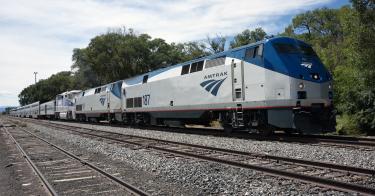New Yorkers already endure the longest commutes in the country. But lately, beleaguered rail commuters frequenting Penn Station have been forced to suffer through especially nightmarish delays and cancellations.
The culprit: serious operational and infrastructure problems emanating from Amtrak, the government corporation that owns and operates the tracks and Penn Station itself.
The issues range from stalled cars to slipshod maintenance that has caused two train derailments. Worse still for commuters who rely on NJ Transit and the Long Island Rail Road, Amtrak plans to shut down multiple tracks over the summer to complete long-deferred maintenance.
The root causes of these problems? Amtrak’s cumbersome structure, mismanagement and poor incentives all combine to give New Yorkers the short end of the stick when it comes to rail service.
Established in 1971, Amtrak is a federally funded railroad with what amounts to a monopoly on intercity rail travel in the U.S. Unable to recoup its costs in fares, it receives $1.5 billion in subsidies each year courtesy of federal taxpayers. The combination of little competition and heavy subsidies results in a railroad that seldom responds to its customers’ needs.
Structurally, Amtrak is not well designed to serve the New York region. The Northeast Corridor — stretching the densely populated megalopolis from D.C. to Boston — is Amtrak’s most traveled route, carrying more than 12 million people per year (38% of Amtrak’s ridership).
Unlike the railroad’s other routes, which rely on freight rail tracks, Amtrak owns and is responsible for maintaining the infrastructure on the Northeast Corridor. It is, Amtrak claims, its most profitable route (but only if you ignore depreciation and maintenance costs).
Yet because of politics, Amtrak is required to funnel resources to poorly performing long-distance routes that traverse sparsely populated swaths of the country, such as those from Chicago to San Francisco and New Orleans to Los Angeles. Maintaining these long-haul routes require Amtrak to serve areas where passenger rail makes little sense — especially compared to faster and cheaper services such as air travel and buses. Although these routes account for only 14% of Amtrak’s ridership, they make up 87% of the railway’s operating losses.
But even on more viable routes, Amtrak’s costs are out of control. The railroad’s heavily unionized workers extract an average compensation that exceeds six figures and are subject to inefficient and inflexible work rules. The annual cost of an Amtrak infrastructure worker is 2.3 times that of a railroad worker in Europe (itself no bastion of efficient employment rules). It routinely pays extravagant sums for its equipment, thanks in no small part to cumbersome federal procurement rules.
It’s clear that Amtrak is not working for the Northeast. Better serving the nation’s largest metro area requires a structural fix that goes beyond piling on additional subsidies that would do little to improve the lack of incentives Amtrak faces.
First, the Northeast Corridor is the most important passenger rail link in the country, and possibly the only one that is economically viable. It should be made a wholly independent rail system from the rest of Amtrak’s national network. (To its credit, Congress took a meaningful step in 2015 by separating the funding and accounting for the Northeast Corridor, allowing for greater autonomy.)
Amtrak should then introduce competition to the Northeast Corridor by bidding out the right to operate and maintain the route to minimum specifications laid out by the government.
This approach would have myriad benefits. Allowing firms to compete to provide service would, of course, decrease costs to taxpayers and improve service for customers. But it would also add an additional element of accountability that is currently non-existent for the monopoly railway. Accountability would be greatly increased by including provisions in the concession contract that allow the government to withhold revenues if a certain level of service is not met, or even to terminate the contract in the case of a catastrophic incident.
Introducing competition to Amtrak’s most viable route could drastically improve service on the nation’s most heavily travelled passenger rail corridor and deliver upfront cash from the concessionaire to be reinvested in capital projects. Ultimately, the Northeast Corridor should explore outright privatization, as Japan has done with its acclaimed Central Japan Railway Company.
A similar approach should be examined for management of Penn Station. Although Amtrak already brings in private contractors to handle operations in certain parts of the station, establishing an independent entity, such as a non-profit corporation, to manage the entire station could holistically improve Penn Station governance.
This model — similar to that of an airport providing service to multiple airlines — would get the feds out of managing a vital, local hub for New Yorkers, and cut down on bickering between the three government-run railways. Given that Amtrak only operates a small minority of daily train service to Penn Station, it makes no sense for the entity to be running the nation’s busiest rail station.
Although much attention is consumed by grandiose projects with billion-dollar price tags, these fundamental changes that improve competition and empower local governance come at little cost to taxpayers and could drastically improve daily travel for millions of people.
New York has always been the nation’s fastest moving city. Poor railway performance shouldn’t hold it back.
This piece originally appeared in New York Daily News


